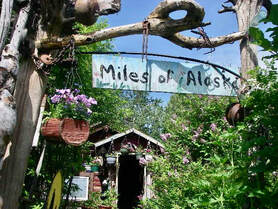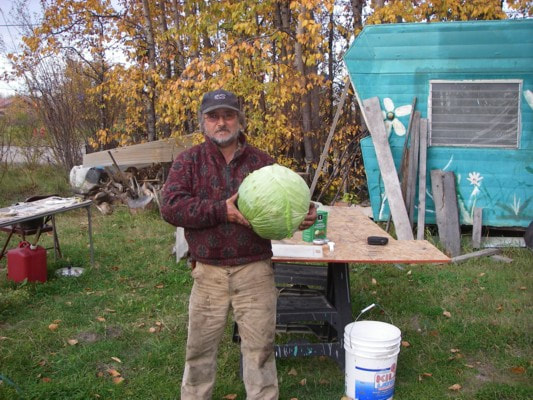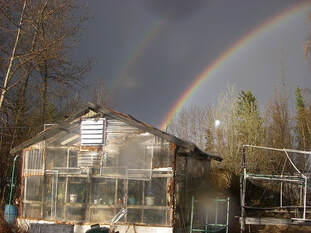Miles Gardening
Alaska gardening
I send out updates to people interested in Alaska garden news. This web page has supplemental, and the latest news kept in one place, organized. Here I can add pictures, stories, and updates, links to my sources and ‘how to’ related. I assume you arrived here from a link off my blog or mailer list.
Recent News
I send out updates to people interested in Alaska garden news. This web page has supplemental, and the latest news kept in one place, organized. Here I can add pictures, stories, and updates, links to my sources and ‘how to’ related. I assume you arrived here from a link off my blog or mailer list.
Early March 2022
I'm still in Tucson after doing the gem fossil show. I will be back home in Alaska April 1st and getting the greenhouse going. In my view a tad late. Ideally, I begin the grade season in early March with seeds on the window sill in the house.
Of interest might be that I take advantage of availability and lower prices down south. If you travel but garden up north... I buy bulk vegetables in the area I am. Like here it is peppers, tomatoes, things easy to grow here maybe coming in from Mexico. I dehydrate these inexpensive foods so they ship home light at little cost. I now have 'food' for the rest of the year in a high economy environment where I might not afford peppers and they are hard to grow. I acquire figs dates, pecans, vanilla extract as foods that are around this area that I can utilize in my cold Alaska environment. I view 'gardening' as not just ‘fun’ but the topic becomes food, survival, where we get it, how get healthy, economically and provide ourselves in hard times as a kind of survival. Not all gardeners are into the survival aspect, but it is one advantage of growing yourself.
I also grow all my own flowers in the greenhouse for hanging baskets I could not afford to buy. Like 100 flower baskets for pennies. This becomes a part of a business write off. Hanging baskets being part of my business presence. Support the greenhouse and gardening economically is a subject of interest to me since one reason people grow it so save money. I might add, that once I get the greenhouse started, it Is not much more work to fill it up, then to run it with just a few trays.
If you also sell at a farmers’ market, this can be part of a business, allowing gardening write offs. This for me becomes part of an entire lifestyle of 'subsistence.' How to live off the land. The economics becomes a big part, as we all need time to do gardening and how do we buy that time?
Composting
All winter all year around I am composting. This makes it a good subject to cover in a winter discussion. In the far north, composting is a challenge. Keeping the compost contained up off the permafrost ground helps. I built a 4x4 wood bin, but with windows added to let light in to build up heat in the summer 24 hours light. And or I use a big window (It can be cracked, used, cheap, acquired at the dump- garage sale ) for my lid on hinges. I ended up with 3 bins or divisions in this contained space. One pile is the oldest and one that gets used ‘this year’ for the garden. One next to it is ‘In the process still.’ The 3rd is ‘newly added’. So bin 3 is where I am tossing stuff all year round, like egg shells, coffee grounds, banana peels and such. All dinner scraps duck feathers bones anything compostable. In winter this freezes and becomes quite a huge mass. Composting ends up an art form, especially in the far north. I take the bottom of bin 3 in spring as soon as it thaws, like early May, and add it to the top of bin 2… mixing in some old leaves and layering with this and that. This takes care of the fact compost needs turning! In bin 2 I layer winter sawdust, last falls bagged leaves, and or mowed grass clippings, and hunks of rotting wood. Layering helps, no more than a foot per layer. I even add charcoal from the wood stove I save up to make ‘biochar.’ I add powdered bone meal. If I do this in layers, my compost is twice as good. Once a year in fall I pull the bottom of pile 2 and add it to pile 1. It should be close to done for spring use. I pull out sticks and obvious big stuff, maybe bones and toss that back into bin 3 to compost for another year. I choose fall because I need room in pile 3 for all the garden debris after harvest, like squash leaves vines etc. Much labor beyond this helps, but may not be cost effective. I do find that the mentioned extra effort is very worthwhile. Often if you just toss things into a pile and call it good, no it Is not, and my not even work out, it may not even compost at all. I do not take internal temperatures. I go more by how it all looks, as it goes into each bin. I’m told it takes a 4x4x4 pile in Alaska to work ok. This size may not freeze in the center all winter. This keeps bugs, microbes, worms, nematodes, alive until spring warmth.
Oh, I chainsaw an access into the bottom of each bin section and simply prop that cut out piece back in place. I can remove this cut out and access the bottom of the pile with a shovel or pitch fork. Or I may temporarily remove an entire side of the bin. No the pile does not just spill out all over! The compressed pile seems to hang together as a cube, even with the side missing it’s just a compact wall of ‘stuff.’ If the board wall will not go back I use a drop piece of plastic and lean the board up against that.
Oh. All summer long I lift the compost glass lid and use the garden hose to water down my pile. It must be damp to compost. With a lid, rain does not get in well and there is not enough rain in interior Alaska for good compost wetting. Or use a rain gutter to focus rain into the bin.
Oh. And I line the bottom of all bins with plastic as I find many nutrients run off into the soil if I do not contain it at the bottom.
Oh. And now and then I take good compost from bin 1 and sprinkle it into the top of bin 3. This help inoculate the pile with needed bacteria.
Oh And I seek out horse and or pig- goat chicken manure and bedding from a nearby farm as manure is so great as a compost additive! However beware, if not composted well this adds uncontrollable weed seeds to your garden! I have seen this discourage gardeners from even composting at all Yikes! However by my method of 3 piles and 3 years there are no more weed seeds that survive. I see composting much like the actual garden in terms of how it works. If you just toss seeds out on the ground and call that ‘gardening,’ you may be disappointed in the results, right? The more you do to help those seeds grow, the more produce you get! Similar with composting. Just tossing debri in a pile and forgetting about it for a year, then calling that all you need to know to have good compost is not really workable in Alaska reality.
I may eventually make a video on just ‘composting,’ as it is a special interest and I took college level classes on the subject, and been doing this in the far north a lot of years now, so have more the a basic knowledge to pass along, best taught in a ‘how to’ video. This is one reason to sign up for the mailer, to get notified when this video and other information is available. It’s all about having enough time.
In the future I plan to add topics like growing apples, fruit trees, maybe how to put the garden up by canning, drying, pickling. But this is still winter! Other things on my mind and occupying my time right now.
Early March 2022
I'm still in Tucson after doing the gem fossil show. I will be back home in Alaska April 1st and getting the greenhouse going. In my view a tad late. Ideally, I begin the grade season in early March with seeds on the window sill in the house.
Of interest might be that I take advantage of availability and lower prices down south. If you travel but garden up north... I buy bulk vegetables in the area I am. Like here it is peppers, tomatoes, things easy to grow here maybe coming in from Mexico. I dehydrate these inexpensive foods so they ship home light at little cost. I now have 'food' for the rest of the year in a high economy environment where I might not afford peppers and they are hard to grow. I acquire figs dates, pecans, vanilla extract as foods that are around this area that I can utilize in my cold Alaska environment. I view 'gardening' as not just ‘fun’ but the topic becomes food, survival, where we get it, how get healthy, economically and provide ourselves in hard times as a kind of survival. Not all gardeners are into the survival aspect, but it is one advantage of growing yourself.
I also grow all my own flowers in the greenhouse for hanging baskets I could not afford to buy. Like 100 flower baskets for pennies. This becomes a part of a business write off. Hanging baskets being part of my business presence. Support the greenhouse and gardening economically is a subject of interest to me since one reason people grow it so save money. I might add, that once I get the greenhouse started, it Is not much more work to fill it up, then to run it with just a few trays.
If you also sell at a farmers’ market, this can be part of a business, allowing gardening write offs. This for me becomes part of an entire lifestyle of 'subsistence.' How to live off the land. The economics becomes a big part, as we all need time to do gardening and how do we buy that time?
Composting
All winter all year around I am composting. This makes it a good subject to cover in a winter discussion. In the far north, composting is a challenge. Keeping the compost contained up off the permafrost ground helps. I built a 4x4 wood bin, but with windows added to let light in to build up heat in the summer 24 hours light. And or I use a big window (It can be cracked, used, cheap, acquired at the dump- garage sale ) for my lid on hinges. I ended up with 3 bins or divisions in this contained space. One pile is the oldest and one that gets used ‘this year’ for the garden. One next to it is ‘In the process still.’ The 3rd is ‘newly added’. So bin 3 is where I am tossing stuff all year round, like egg shells, coffee grounds, banana peels and such. All dinner scraps duck feathers bones anything compostable. In winter this freezes and becomes quite a huge mass. Composting ends up an art form, especially in the far north. I take the bottom of bin 3 in spring as soon as it thaws, like early May, and add it to the top of bin 2… mixing in some old leaves and layering with this and that. This takes care of the fact compost needs turning! In bin 2 I layer winter sawdust, last falls bagged leaves, and or mowed grass clippings, and hunks of rotting wood. Layering helps, no more than a foot per layer. I even add charcoal from the wood stove I save up to make ‘biochar.’ I add powdered bone meal. If I do this in layers, my compost is twice as good. Once a year in fall I pull the bottom of pile 2 and add it to pile 1. It should be close to done for spring use. I pull out sticks and obvious big stuff, maybe bones and toss that back into bin 3 to compost for another year. I choose fall because I need room in pile 3 for all the garden debris after harvest, like squash leaves vines etc. Much labor beyond this helps, but may not be cost effective. I do find that the mentioned extra effort is very worthwhile. Often if you just toss things into a pile and call it good, no it Is not, and my not even work out, it may not even compost at all. I do not take internal temperatures. I go more by how it all looks, as it goes into each bin. I’m told it takes a 4x4x4 pile in Alaska to work ok. This size may not freeze in the center all winter. This keeps bugs, microbes, worms, nematodes, alive until spring warmth.
Oh, I chainsaw an access into the bottom of each bin section and simply prop that cut out piece back in place. I can remove this cut out and access the bottom of the pile with a shovel or pitch fork. Or I may temporarily remove an entire side of the bin. No the pile does not just spill out all over! The compressed pile seems to hang together as a cube, even with the side missing it’s just a compact wall of ‘stuff.’ If the board wall will not go back I use a drop piece of plastic and lean the board up against that.
Oh. All summer long I lift the compost glass lid and use the garden hose to water down my pile. It must be damp to compost. With a lid, rain does not get in well and there is not enough rain in interior Alaska for good compost wetting. Or use a rain gutter to focus rain into the bin.
Oh. And I line the bottom of all bins with plastic as I find many nutrients run off into the soil if I do not contain it at the bottom.
Oh. And now and then I take good compost from bin 1 and sprinkle it into the top of bin 3. This help inoculate the pile with needed bacteria.
Oh And I seek out horse and or pig- goat chicken manure and bedding from a nearby farm as manure is so great as a compost additive! However beware, if not composted well this adds uncontrollable weed seeds to your garden! I have seen this discourage gardeners from even composting at all Yikes! However by my method of 3 piles and 3 years there are no more weed seeds that survive. I see composting much like the actual garden in terms of how it works. If you just toss seeds out on the ground and call that ‘gardening,’ you may be disappointed in the results, right? The more you do to help those seeds grow, the more produce you get! Similar with composting. Just tossing debri in a pile and forgetting about it for a year, then calling that all you need to know to have good compost is not really workable in Alaska reality.
I may eventually make a video on just ‘composting,’ as it is a special interest and I took college level classes on the subject, and been doing this in the far north a lot of years now, so have more the a basic knowledge to pass along, best taught in a ‘how to’ video. This is one reason to sign up for the mailer, to get notified when this video and other information is available. It’s all about having enough time.
In the future I plan to add topics like growing apples, fruit trees, maybe how to put the garden up by canning, drying, pickling. But this is still winter! Other things on my mind and occupying my time right now.


